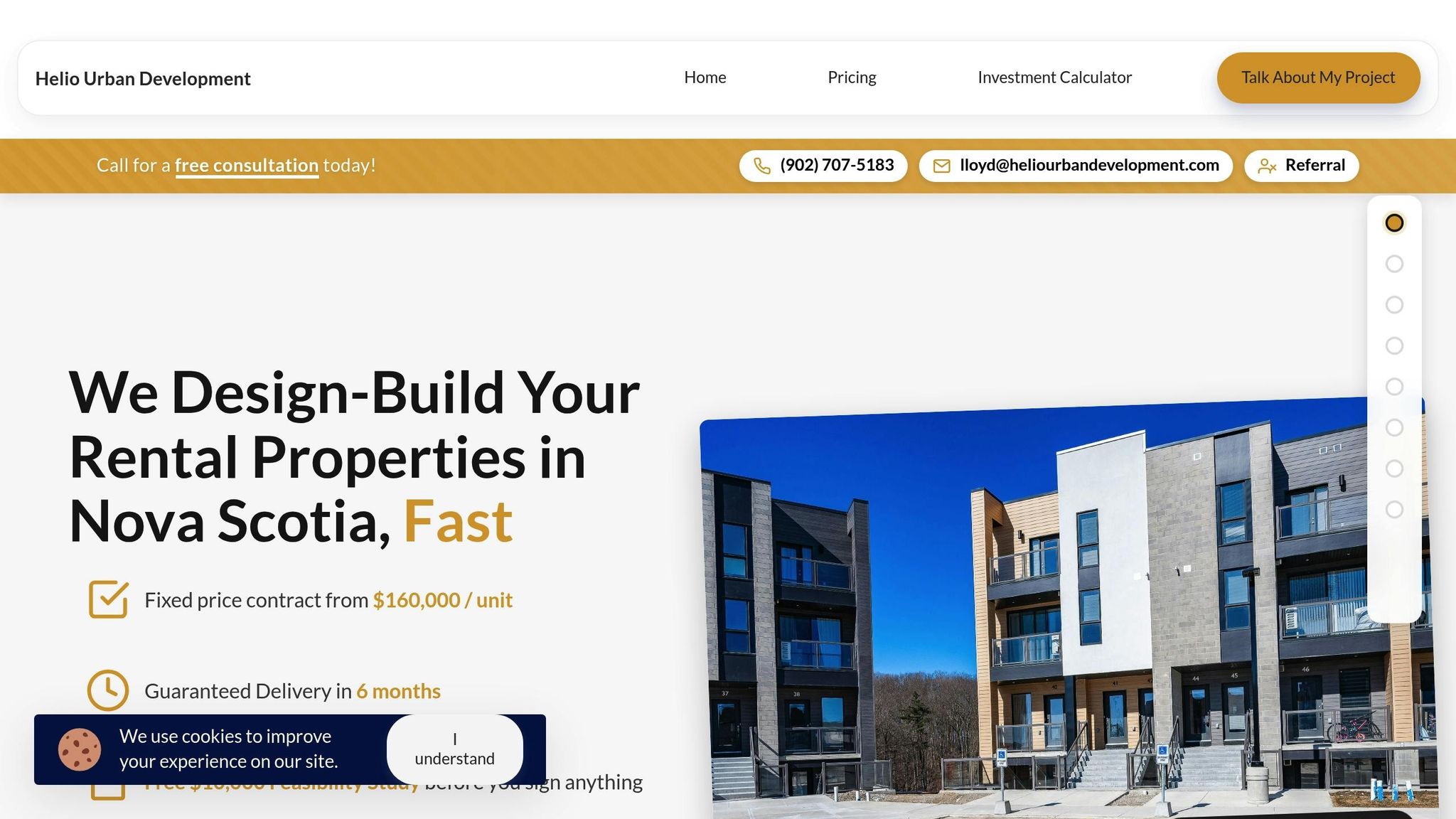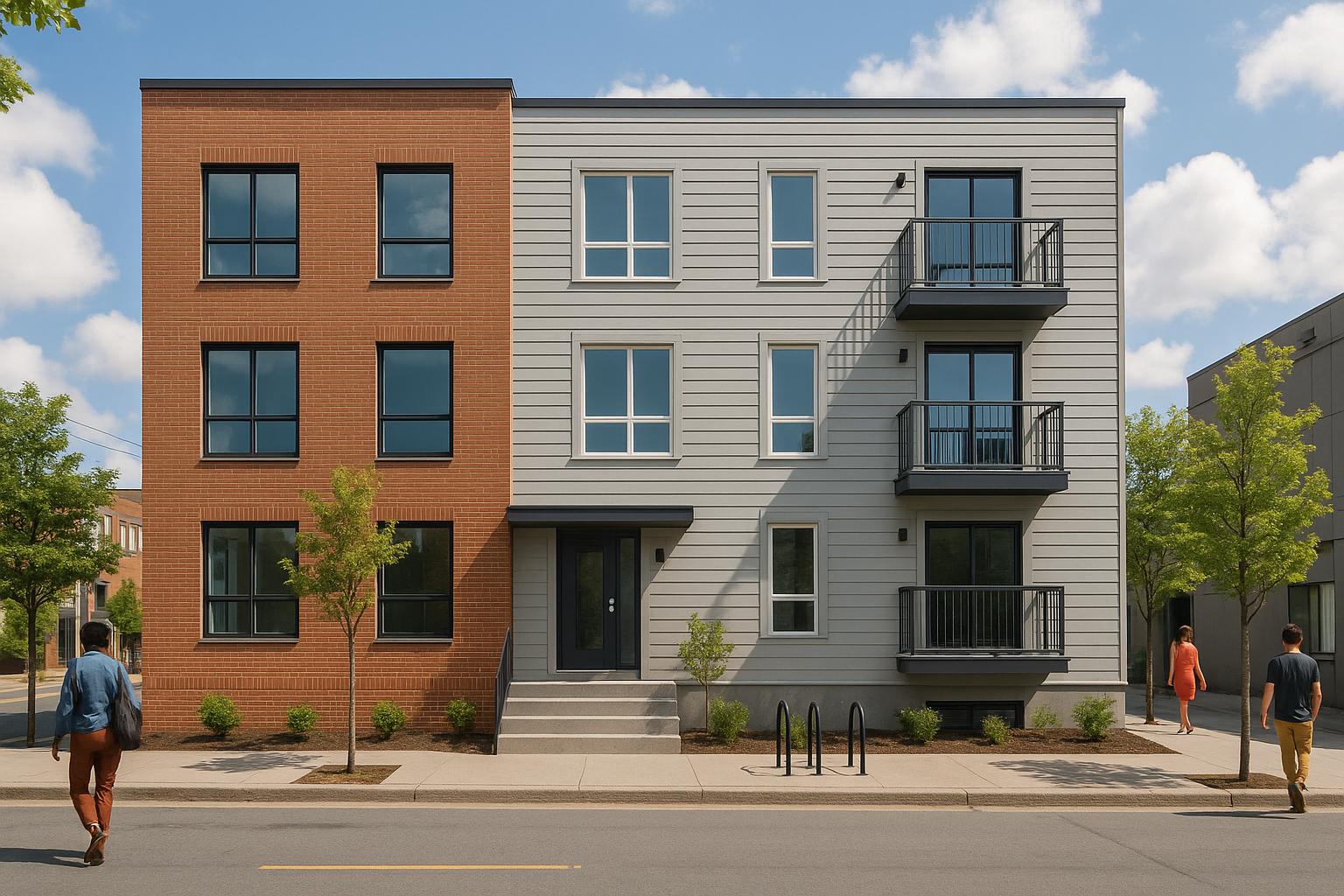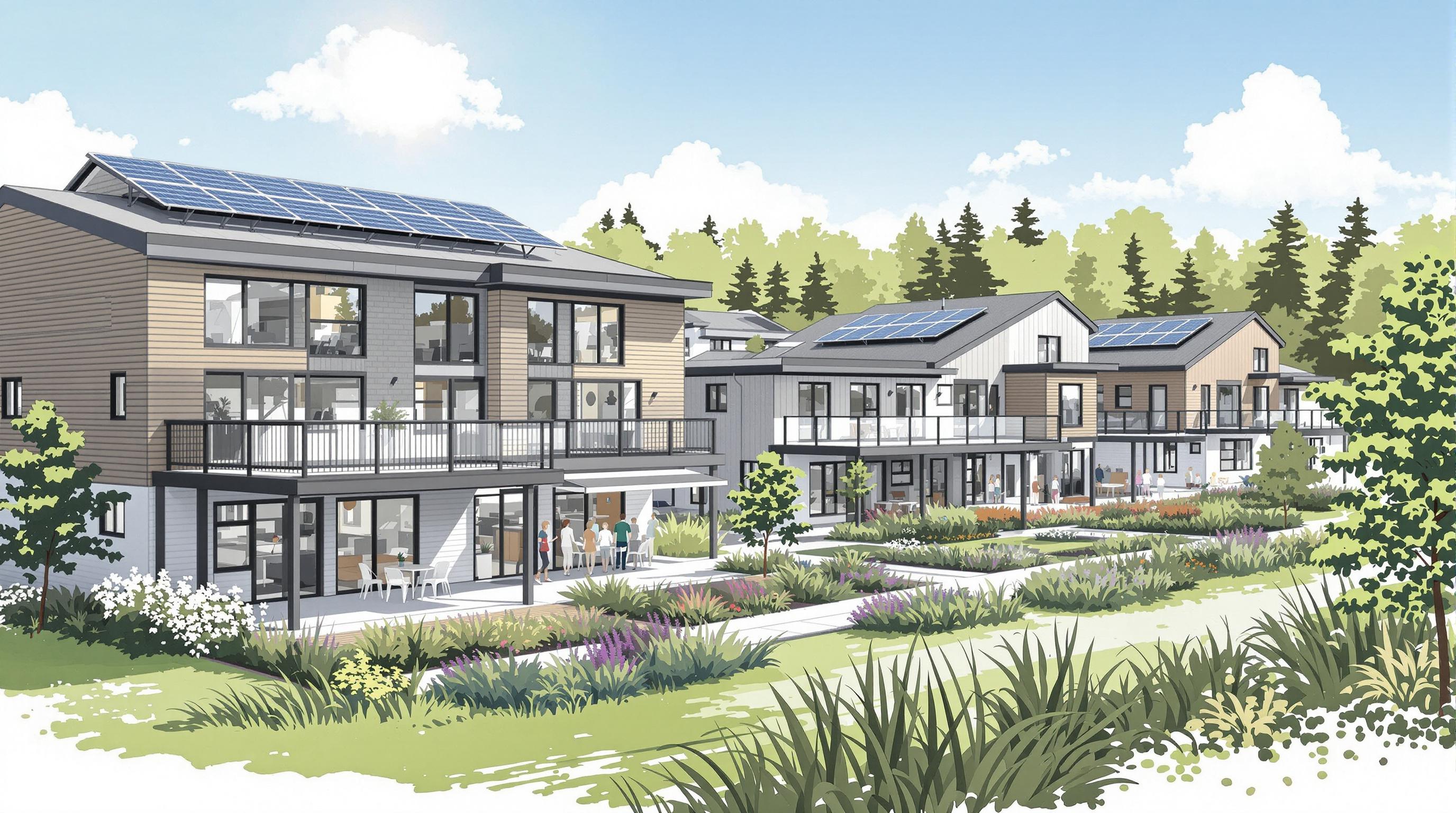If you’re planning to build a multi-unit property in Nova Scotia, getting a building permit is mandatory. Here’s what you need to know:
- Understand Local Rules: Each municipality has specific requirements. Check zoning, setbacks, parking, and more.
- Development vs. Building Permits: Development permits address land use, while building permits focus on construction safety and compliance.
- Prepare Documents: You’ll need detailed plans from certified professionals and preliminary approvals.
- Application Submission: Submit online or in person. Fees and timelines vary by municipality.
- Inspections: Mandatory at key stages - foundation, framing, insulation, and occupancy.
- Avoid Delays: Ensure your application is complete, follow inspection schedules, and resolve zoning issues early.
Working with experienced professionals or design-build companies can simplify the process, reduce delays, and help you meet all requirements. Keep in mind, the process can take weeks to months, so plan accordingly.
2. Introduction to Permitting, Planning, Licensing & Compliance - Customer Website
Step 1: Check Your Local Building Requirements
Before diving into any paperwork or hiring contractors, it’s crucial to understand the specific building requirements in your municipality. Nova Scotia is made up of many municipalities, each with its own rules and regulations that may go beyond provincial standards. What applies in Halifax Regional Municipality might not hold true for Cape Breton Regional Municipality or smaller communities like Truro.
Start by reaching out to your local building department or planning office. They usually have staff who can explain the requirements for multi-unit residential properties. While much of this information is often available on municipal websites, speaking directly with the building department can provide clarity and ensure you’re on the right track. This step is essential for understanding how zoning and permits could influence your project’s scope.
Your property’s zoning designation determines what type of building you can construct and how many units are allowed. For instance, some residential zones permit up to four units without special approval, while others may limit you to a duplex unless additional permissions are granted. To verify your zoning, check your municipality’s online mapping tools or request a verification letter from the planning department. These zoning rules are especially important for multi-unit developments, which often have stricter standards than single-family homes.
Development Permits vs Building Permits: What's the Difference?
Before you start your application process, it’s important to understand the distinction between a development permit and a building permit. Many first-time builders get confused about which permit they need and when.
A development permit focuses on land use and ensures that your project complies with local planning policies. It reviews elements like setbacks from property lines, parking requirements, landscaping, and the overall impact on the neighbourhood. Essentially, it authorizes the land use for your project.
A building permit, on the other hand, deals with the actual construction. It ensures your building meets safety codes, structural standards, and technical requirements. This involves reviewing your architectural plans, engineering details, and construction methods.
In most cases, you’ll need to secure a development permit before applying for a building permit. Some smaller projects in certain zones might only require a building permit, but this varies widely, so it’s best to confirm with your local planning department. Typically, development permits are handled by the planning department, while building permits are managed by the building inspection department. You’ll likely deal with different staff, timelines, and requirements for each permit.
Key Regulations You Need to Know
Multi-unit residential properties come with more complex rules compared to single-family homes. Here are some critical regulations to keep in mind:
- Fire safety: Multi-unit buildings often require enhanced fire safety measures, including proper separations between units, adequate exits, and, in some cases, sprinkler systems.
- Parking requirements: These vary by municipality. Some areas require one parking space per unit, while others may require additional spaces based on the unit size or number of bedrooms. Urban projects near public transit may have reduced parking requirements, whereas rural areas tend to require more.
- Setbacks: These rules dictate how close your building can be to property lines, streets, and neighbouring structures. They ensure sufficient light, air circulation, and privacy while maintaining the neighbourhood’s character. Multi-unit buildings often face stricter setback rules than single-family homes.
- Height and lot coverage limits: These regulations control the scale of your development. Lot coverage refers to the percentage of your property that can be occupied by buildings or other structures, helping to prevent overcrowding and preserve neighbourhood aesthetics.
- Accessibility standards: Under the Nova Scotia Building Code, multi-unit buildings must include features like accessible entrances, wider doorways, and, in some cases, elevator access to upper floors.
- Utility connections: Multi-unit properties may require upgrades to water, sewer, and electrical systems. Contact your utility providers early, as larger developments may need capacity studies, depending on the municipality.
- Environmental considerations: If your property includes wetlands, steep slopes, or other sensitive areas, both provincial and municipal regulations could impact your plans.
To get a full understanding of the rules, review your municipality’s Municipal Planning Strategy and Land Use By-law. These documents are often available online, but their technical language can be tricky. Don’t hesitate to ask planning staff for clarification on any provisions that might affect your project.
Step 2: Collect Required Documents
Once you've reviewed the local requirements, the next step is to gather all the necessary documents. Having everything ready upfront can help you avoid delays during the review process.
Design and Planning Documents
You'll need to submit design and planning documents that show your project complies with the Nova Scotia Building Code Regulation. These documents must be prepared by licensed professionals, such as engineers, architects, or interior designers. They also need to provide Schedule "A" Letters of Undertaking, which confirm their responsibility for overseeing the work [1][2].
After your design documents are finalized, check if there are any preliminary approvals you need to secure before moving forward.
Secure Preliminary Approvals
Some local departments may require preliminary approvals before you can proceed. To make this step easier, many municipalities provide forms, instructions, and checklists to help you through the process [3][4][5]. It's a good idea to address these early on to keep your project on track.
Step 3: Submit Your Application
Once you have all your documents and preliminary approvals ready, it’s time to submit your application. The process can differ depending on the municipality in Nova Scotia, with most offering both online and in-person submission options.
Where to Submit Your Application
Many municipalities now use online submission systems to make the permit process more efficient. For instance, Halifax Regional Municipality has an online portal, and several other communities provide similar options through their municipal websites. Typically, you’ll need to create an account, upload your documents in PDF format, and pay the required fee online. Double-check whether multiple copies of your documents are needed to avoid unnecessary delays.
If you prefer, you can submit your application in person at your local municipal office during business hours. Bring printed copies of all required documents, including your design plans and any preliminary approvals. Municipal staff can review your submission on the spot and inform you if anything is missing or needs adjustment.
Keep in mind that permit fees will vary depending on the size and location of your project. Contact your local authority to confirm the exact cost.
What Happens During Review and Inspections
After submitting your application, it moves to the review stage. During this phase, building officials ensure your plans comply with safety regulations, zoning bylaws, and the Nova Scotia Building Code Regulation. For straightforward multi-unit projects, this review process typically takes a few weeks.
Sometimes, officials may request clarifications or revisions to your plans. Common issues include fire separation details, accessibility features, or parking requirements that don’t align with local standards. In such cases, your design professional will need to address these concerns and resubmit the updated documents.
Once your application is approved, you’ll receive a permit certificate along with an inspection schedule. This schedule outlines the mandatory inspection stages, such as foundation, framing, electrical and plumbing rough-ins, insulation, and final occupancy. Make sure to follow the booking instructions provided by your municipal office, whether that’s by phone or through an online system.
Building officials will inspect each phase to confirm everything meets the required codes. If an inspection isn’t passed, you’ll need to make the necessary corrections before moving forward, which could extend your project timeline.
sbb-itb-16b8a48
Step 4: Avoid Common Mistakes
Once you've started preparing your permit application, it's essential to sidestep some frequent errors that could derail your progress. For many first-time applicants, these avoidable missteps can lead to frustrating delays in getting building permit approvals. By recognizing these common pitfalls, you can save yourself both time and unnecessary stress.
Double-Check for Complete Applications
One of the most frequent reasons for permit delays is submitting incomplete applications. To avoid this, use your municipality's official requirements to create a thorough checklist. Some municipalities, like Clare and East Hants, even provide their own checklists and contact information for building inspectors to help confirm that your application is complete before submission [6][7]. Reaching out to a building inspector for a pre-review is a smart move to ensure your documents align with local standards.
Another common issue is zoning. Make sure your property’s zoning designation allows for the number of units you’re planning to build. Overlooking this step can lead to significant setbacks.
Additionally, review the full scope of your project to confirm that every aspect is covered under your permit. For example, if your plans include elements like decks or finished basements that aren’t part of the original permit, you’ll need to apply for separate approvals. Submitting all necessary permits at the same time can help you avoid construction delays down the road.
Taking these extra steps ensures your application is complete and aligned with local requirements, reducing the likelihood of unnecessary setbacks.
Local Rules Differ by Municipality
While ensuring your documents are in order is crucial, it's equally important to understand that building permit processes can vary widely depending on your municipality. Even though the National Building Code applies throughout the province, municipalities may have their own additional requirements or interpret the code in unique ways [7].
For instance, some areas might require you to submit paper documents in person, while others accept online submissions. These differences in application procedures can catch first-time applicants off guard, so it’s essential to verify the specific process with your local building department.
Inspection requirements also vary. Most municipalities require at least 24 hours' notice to schedule mandatory inspections [6]. Missing an inspection or failing one could delay your project’s timeline or force you to redo work. Understanding how inspections are scheduled in your area will help you avoid such setbacks.
Other local variations, like setback and parking requirements for multi-unit properties, can also differ significantly. Consulting your municipality’s bylaws is key to ensuring your plans comply with spatial and parking regulations.
To avoid surprises, research your municipality’s specific rules thoroughly before finalizing your building plans. Reach out to your local building department to clarify any uncertainties, and consider attending municipal council meetings where updates to building bylaws are discussed. Taking this proactive approach can help you sidestep costly revisions and resubmission delays.
Step 5: Costs and Timeline Planning
When applying for building permits, it’s easy to misjudge the time and money involved, especially for first-time applicants. This can lead to unexpected expenses and frustrating delays. To keep your multi-unit project on schedule and within budget, it’s crucial to plan carefully. Here’s a breakdown of the costs and timelines you should consider.
Permit Fees and Additional Expenses
Permit fees aren’t one-size-fits-all - they depend on factors like the value, complexity, and location of your project. Fees might be calculated as a percentage of the total project cost or charged as a flat rate. Beyond the permit itself, you’ll likely encounter other costs, such as:
- Development permits
- Fees for mandatory inspections
- Professional services like architectural plans and engineering reports
- Assessments related to environmental or traffic impact
- Utility connection charges
To avoid surprises, check your municipality's guidelines for the most up-to-date fee structures.
Timeline Expectations
The time it takes to get permit approval varies depending on the complexity of your project, how complete your application is, and how busy your local municipality is. Keep in mind that applications often go through multiple review stages, and construction schedules can face delays, especially during peak seasons like spring and summer when municipalities process more applications.
It’s wise to build in extra time for potential setbacks, including re-inspections. From submitting your application to breaking ground, the process can take several months. More intricate projects may require even longer. By setting realistic timelines and budgets, you’ll be better prepared to move forward and collaborate with design-build professionals in the next phase.
Step 6: Working with Design-Build Companies
Design-build companies simplify the entire construction process by managing everything from initial permits to the final build. By combining design and construction under one roof, this approach can save you months of back-and-forth coordination and help you avoid unnecessary costs. It’s a practical way to speed up permitting and cut down on expenses.
Why Choosing One Company Matters
When you work with separate professionals - like an independent architect, engineer, and builder - coordination can become a nightmare. Miscommunications and delays are common, and they can quickly inflate your budget. Studies show that property owners lose an average of $47,000 dealing with coordination issues when managing separate teams.
With a design-build company, everyone - from the architect to the construction crew - is on the same team. This unified approach means potential issues are caught early in the design phase, not during construction when fixes are more costly. Plus, having a single point of contact ensures faster responses to municipal authorities, whether it’s about changes or additional documentation.
| Approach | Coordination | Timeline (Savings) | Fixed Price | Risk of Delays |
|---|---|---|---|---|
| Design-Build (Integrated) | High | Shorter (up to 2 months saved) | High (fixed price) | Low |
| Traditional (Separate Teams) | Low | Longer | Variable | Higher |
A great example of this streamlined process is Helio Urban Development.
How Helio Urban Development Simplifies Permits

For first-time property owners, working with an integrated firm like Helio Urban Development can take much of the guesswork out of obtaining permits. Based in Nova Scotia, Helio is the province’s only design-build company specializing in multi-unit rental properties. The company was founded after its team experienced firsthand the frustrations of traditional construction coordination.
Helio starts the permitting process during the design phase, with architects and engineers crafting plans that align with municipal requirements. This approach minimizes revisions and speeds up approvals. Currently, Helio has 31 units under construction across Nova Scotia, with plans for 131 more, all within a 90-minute radius of Halifax.
Their fixed-price model is $160,000 per unit, with a six-month completion guarantee. To back up this promise, they include penalties of up to $1,000 per day for delays. For first-time property owners, Helio offers daily photo updates and access to a real-time project portal, so you can track progress from anywhere. Construction is inspected five times by a professional engineer, and you even get to choose the final inspector. The result? Bank-grade quality with a two-year warranty on all work.
If you’re considering a design-build company, look for firms with a strong history in multi-unit residential projects, a deep understanding of local permitting processes, and transparent pricing. Reviewing timelines and references from past projects can help you gauge their reliability. When design and construction teams work together from day one, the permitting process becomes far smoother - allowing you to focus on your investment goals without unnecessary stress.
Key Points for First-Time Permit Applicants
Starting the permit process on the right foot requires careful planning. A smart first step is reaching out to your local building office early. This helps you understand the specific requirements for your area and avoids any unexpected issues later on.
Before submitting your application, make sure all preliminary requirements are addressed. For instance, resolve any property-related approvals like septic systems, wells, or driveway permits in advance. These can cause significant delays if not sorted out beforehand. It's also worth noting that some projects, such as fences, cosmetic repairs, or small accessory buildings under 144 square feet, might not require permits. Always double-check with your municipality, as regulations can differ across Nova Scotia.
Be prepared for five mandatory inspections throughout your project: footings, foundation, framing, insulation, and pre-occupancy. Each inspection ensures your construction meets safety and building code standards. Missing or failing these checks can bring your project to a standstill and delay your occupancy permit [6].
If you make changes to your project after receiving your permit, additional permits may be needed. For example, adding a deck, finishing a basement, or making other modifications not included in your original application will require separate approvals. To avoid this, take time to fully plan your project before submitting your initial permit application.
The application method you choose can also affect timelines. Online applications are typically processed within 2–4 weeks, while paper submissions may take 3–6 weeks. Being well-prepared and choosing the right method for your project’s complexity can help streamline the process.
Finally, working with experienced professionals can make a world of difference. Whether you hire an integrated design-build company or seasoned consultants, having experts who understand local requirements can save you significant time and stress. Their expertise can help you navigate the process more efficiently, ensuring everything runs smoothly from start to finish.
FAQs
What mistakes should first-time applicants avoid when applying for a building permit in Nova Scotia?
First-time applicants often stumble into common pitfalls like ignoring local zoning rules, not meeting building code standards, or submitting incomplete applications. These missteps can cause frustrating delays or, worse, outright rejections of your permit.
To sidestep these challenges, start by thoroughly reviewing your municipality's zoning bylaws to confirm your project fits within the regulations. Ensure your plans comply with requirements for fire safety, accessibility, and energy efficiency. Gather all necessary documents - such as detailed construction drawings and site plans - before submitting your application. It’s also a smart move to consult with local officials early on to clarify expectations and avoid any surprises down the line.
How can a design-build company simplify the building permit process for multi-unit properties in Nova Scotia?
A design-build company in Nova Scotia makes obtaining building permits for multi-unit properties much easier by offering both design and construction services through a single, unified team. This approach improves communication, cuts down on delays, and helps prevent the typical missteps that can occur when designers and builders work separately.
By maintaining close collaboration with local authorities, design-build teams ensure that every plan aligns with municipal regulations and requirements. This proactive coordination speeds up the approval process, saving time and reducing hassle. For property owners, it means less stress and more confidence to focus on their project.
What zoning or regulatory challenges should I expect when planning a multi-unit rental property in Nova Scotia?
Zoning and regulatory requirements for multi-unit developments in Nova Scotia differ widely across municipalities. Take Halifax, for instance - while the city has implemented zoning reforms to streamline approvals and support multi-unit rental projects, developers might still face delays due to rezoning or variance applications. Meanwhile, in areas like Kings County, rezoning to classifications like R4 for multi-unit housing often involves extra steps and approvals, adding complexity to the process.
Some frequent hurdles include strict zoning rules, possible pushback from the community, and the need for variances, all of which can stretch timelines and inflate costs. To stay ahead, it’s crucial to dive into municipal regulations early in your planning and work closely with local authorities to fully grasp the specific requirements for your development.



